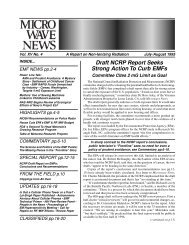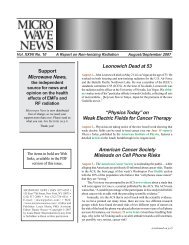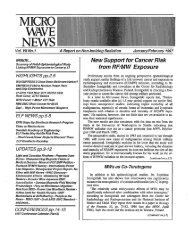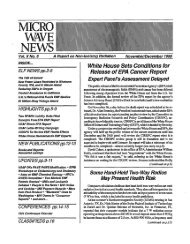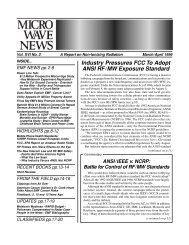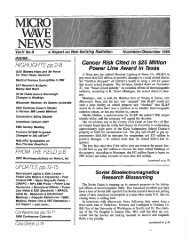Mobile Phones, Cancer Not Linked In Two Short ... - Microwave News
Mobile Phones, Cancer Not Linked In Two Short ... - Microwave News
Mobile Phones, Cancer Not Linked In Two Short ... - Microwave News
Create successful ePaper yourself
Turn your PDF publications into a flip-book with our unique Google optimized e-Paper software.
Special Report: <strong>Mobile</strong> <strong>Phones</strong> and <strong>Cancer</strong><br />
The NCI Study<br />
The NCI enrolled 782 cases and 799 controls from admissions<br />
to hospitals in Boston, Phoenix and Pittsburgh between<br />
1994 and 1998. There were 489 patients with glioma, 197<br />
with meningioma and 96 with acoustic neuroma.<br />
18% of cases and 22% of controls were regular users,<br />
defined as a minimum of two calls per week. 17 cases (2%)<br />
and 28 controls (3.5%) used a mobile phone for fifteen minutes<br />
or more per day for at least three years. Proxy interviews<br />
to determine cell phone use, inter alia, were necessary<br />
for 16% of patients with glioma, 8% with meningioma and<br />
3% with acoustic neuroma.<br />
The relative risk of brain tumors (both malignant and<br />
benign) ranged from 0.6 to 1.1 for any duration or extent of<br />
wireless phone use. None of these risks was significant.<br />
There was no link between the side of the head where<br />
people usually held their phone, and the side of the brain on<br />
which the tumor occurred. There was no excess risk of a<br />
tumor in any particular lobe of the brain.<br />
The NCI study, led by Drs. Peter <strong>In</strong>skip, Martha Linet<br />
and Robert Tarone, was published in the January 11 issue of<br />
the New England Journal of Medicine (344, pp.79-86, 2001).<br />
The AHF Study<br />
The AHF enrolled 469 cases and 422 controlsfrom patients<br />
admitted to five different U.S. hospitals between 1994<br />
and 1998. 102 eligible cases were eliminated because they<br />
had died, refused to participate or were too ill to respond.<br />
14% of cases and 18% of controls were regular users of<br />
cellular phones, defined as having had a mobile phone service<br />
subscription. The average duration of use was 2.8 years<br />
for cases and 2.7 years for controls, with a median use of 2.5<br />
hours a month for cases and 2.2 for controls. 17 cases and<br />
22 controls used a cell phone for four years or more.<br />
Risk of brain cancer did not rise with number of years of<br />
use, number of hours on the phone per month, or with hours<br />
of cumulative use: For each of these subdivisions, odds ratios<br />
ranged from 0.5 to 1.1, none of the risks being statistically<br />
significant.<br />
Among cases, 26 had brain tumors on the same side of<br />
the head where the phone was usually held, compared to 15<br />
whose tumor was on the opposite side. This was just short<br />
of a significant association (p=0.06). However, when the<br />
analysis was limited to tumors in the temporal lobe, the reverse<br />
was true: More patients had tumors on the opposite<br />
side from where they held the phone (9 vs. 5).<br />
<strong>In</strong> examining the data on different tumor subtypes, only<br />
neuroepitheliomatous tumors showed any association with<br />
mobile phone use. For this type of cancer, phone users had<br />
an odds ratio of 2.1 (CI=0.9-4.7).<br />
The AHF study, led by Joshua Muscat and Dr. Mark<br />
Malkin, was published in the Journal of the American Medical<br />
Association (284, pp.3001-3004, 2000).<br />
<strong>Two</strong> New Epi Studies (continued from p.1)<br />
TWO STUDIES REPORT NO LINKS TO CANCER IN CELL PHONES’ USE,<br />
said a front-page headline in the New York Times (December<br />
20). MOBILE PHONES CLEARED OF LINK TO BRAIN TUMORS, declared<br />
the U.K.’s Daily Telegraph (December 20). A few media outlets<br />
were more cautious—for instance, Wired’s online news service<br />
titled its story NO CANCER? TOO EARLY TO CALL (December 21).<br />
“Based on the evidence we have today, not just our study but<br />
all studies taken together, I don’t think we see any evidence of<br />
increased risk from using cell phones,” <strong>In</strong>skip told <strong>Microwave</strong><br />
<strong>News</strong> in January. “To that extent the results are reassuring, but<br />
clearly it’s not the end of the story.” <strong>In</strong> a press statement in December,<br />
<strong>In</strong>skip noted that, “If an increased risk of brain tumors<br />
occurs only after five or more years, or only among very heavy<br />
users, this study probably would not detect it.”<br />
<strong>In</strong>skip is also the author of an editorial on the first study of<br />
eye cancer among wireless phone users, both published in the<br />
January issue of Epidemiology (see p.9). Another mobile phone–<br />
cancer study, by Dr. Christoffer Johansen of the Danish <strong>Cancer</strong><br />
Society in Copenhagen, is scheduled for publication in February<br />
in the Journal of the National <strong>Cancer</strong> <strong>In</strong>stitute (see box, p.12).<br />
Many of the comments on the NCI and AHF studies focused<br />
on their relatively short time frame. For example, Dr. David Samuels<br />
of the Australian Radiation Protection and Nuclear Safety<br />
Agency told the Melbourne paper the Age (December 22), “Ionizing<br />
radiation, such as X-rays, which are a known carcinogen<br />
and which cause a number of cancers, can take up to 20 years”<br />
to have an effect. “Therefore these studies haven’t been going<br />
on long enough,” Samuels said (see box, p.11).<br />
<strong>In</strong>skip responded that, “You have to remember how this issue<br />
came up. It really was through case reports of glioblastoma<br />
in the early 1990s, which occurred in the same area where people<br />
had held their phones. And our study does show that there’s no<br />
evidence that those tumors were caused by cell phone use.”<br />
David Reynard, whose appearance on Larry King Live shook<br />
the cellular phone industry in 1993, had said that his wife Susan’s<br />
brain tumor made “a perfect bull’s-eye” on the location of her<br />
phone’s antenna (see MWN, M/J92 and J/F93). Public concern<br />
was heightened by reports of brain cancer among other heavy<br />
users of mobile phones, such as the head of Beatrice Foods and<br />
Republican political consultant Lee Atwater.<br />
The NCI and AHF studies included few people with heavy<br />
cellular phone use. Only 13 of 469 cases in the AHF study used<br />
their phones more than 20 minutes daily, and only 35 of NCI’s<br />
782 cases had a daily average over 15 minutes.<br />
The two studies also had few subjects who had been mobile<br />
phone users for very long. Out of 469 cases in the AHF study,<br />
only 17 had had a cellular phone subscription for more than three<br />
years. <strong>In</strong> the NCI study, only 54 out of the 782 people with brain<br />
cancer had used a mobile phone for three years or more.<br />
The combination of heavy use and long-standing use was<br />
rarest of all: For example, only 17 of the NCI’s cases averaged<br />
more than fifteen daily minutes for three years or more.<br />
Dr. Mark Malkin, a neuro-oncologist at Memorial Sloan-<br />
Kettering <strong>Cancer</strong> Center in New York City and a coauthor of the<br />
AHF study, said, “It is not a complete vindication of cell phones.”<br />
MICROWAVE NEWS January/February 2001 10



